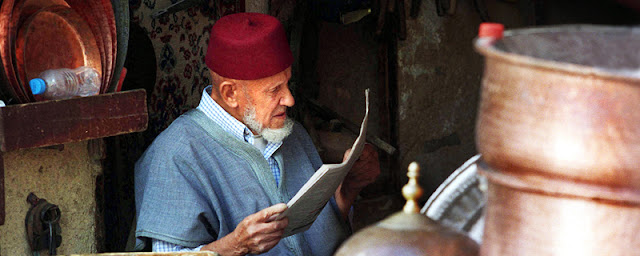Disney's new Prince of Persia: The Sands of Time, to be released on 28 May, was filmed in Morocco, around Ouarzazate, Marrakech and Merzouga.
This costume/adventure movie was directed by Mike Newell, produced by Jerry Bruckheimer and stars Jake Gyllenhall, Ben Kingsley, Gemma Arterton and Alfred Molina.
The story revolves around Gyllenhaal's character, a rogue prince, who joins forces with a mysterious princess to prevent an ancient dagger from releasing the Sands of Time — gift from the gods that can reverse time and allow its possessor to rule the world.
The View from Fez came across these quirky facts at tv.com:
AIM HIGH — The first shooting location for
Prince of Persia: The Sands of Time was at an altitude of 8,200 feet in the mountain village of Oukmaiden in the High Atlas Mountains, surrounded by indigenous Berber communities. The cast and crew had to acclimate themselves before proceeding with the demanding action sequences filmed there.
SANDS OF TIME, INDEED — The production battled ferocious sandstorms in of Ouarzazate, Morocco.
HEATED — Morocco offered 100+-degree Fahrenheit temps during production. Massive, air-conditioned tents were erected at the Lycee Hassan II school in Marrakesh. One, which was the size of a football field, housed wardrobe, hair and makeup for the film's background players. And adjoining tent was built just for washing and drying. It was a mind-blowing 124 degrees on the last day of Moroccan filming (Merzouga Sand Dunes outside of Erfoud). According to Morocco Facilities Manager Gregoire Mouveau, during filming in that country the
Prince of Persia company consumed 1,114,894 bottles of water.
OSTRICHES — Typical warnings on call sheets in Morocco: 'PLEASE DO NOT TOUCH THE OSTRICH ON SET TODAY' or 'BEWARE – SNAKES & SCORPIONS CAN BE FOUND AT THIS LOCATION UNDER AND AROUND THE ROCKS. BE CAUTIOUS.'
IT TAKES A VILLAGE — In Morocco, there were a combined 1,350 cast and crew members, including 800 local Moroccans. Adding the 500 people working in post-production, the total cast and crew amounted to more than 1,850.
SNAKE DUDE — A local Moroccan was hired to clear the shooting areas in the desert of a vipers and scorpions. Donning a t-shirt emblazoned with "Snake Dude," he was easy to spot.
LOCAL LANDMARKS — The Nasaf marketplace and city gates were built adjacent to the UNESCO World Heritage site of Ait Ben Haddou, but the original structure was untouched by the filmmakers.
DAGGERS — Some 20 different versions of the Dagger which holds the Sands of Time were fabricated for the film — from the "hero" version, made of steel, to latex versions, created for stunt sequences.
OSTRICH RACES AND ROMANCE — The only other ostrich race scene other than the one shot for
Prince of Persia was for another Disney movie — the 1960 version of
Swiss Family Robinson. The moment in which Alfred Molina, as Sheikh Amar, kisses his favorite ostrich on the neck was completely unscripted. "I thought I would either get my eye poked out," notes Molina, "or that I would get away with a funny moment."
STRAIGHT TO THE SOURCE — The film's parkour adviser is none other than France's David Belle, who actually invented parkour.
A NUMBERS GAME — The exterior set of Alamut, designed by Wolf Kroeger, was constructed around the actual 700-year-old walls of the village of Tamesloht, 20 kilometers southwest of Marrakesh. It required 30 miles of scaffold tubing and 400 tons of plaster, with 350 members of the construction crew. The colorful frescoes and mural paintings which adorn the set were painted in seven weeks. The Alamut Eastern Gate set built at Pinewood Studios' "007 Stage," also designed by Wolf Kroeger, required 3,000 eight-by-four-foot sheets of wood, 70,000 feet of three-by-one inch timber, and 40 tons of casting plaster for moldings. It was constructed in a relatively brief 14 weeks.
ARMED AND DANGEROUS — Armorer Richard Hooper and his department fabricated 3,500 individual items, including swords, shields, spears, axes, arrows, bows, quivers, scabbards, bow cases, daggers and Hassansin weapons.
EPIC A.D. — Working on the film for a few days at Pinewood Studios in England was legendary British assistant director Michael Stevenson, who knows a thing or two about epics having worked on
Lawrence of Arabia,
The Fall of the Roman Empire,
Doctor Zhivago,
The Charge of the Light Brigade and
Barry Lyndon.
COSTUMES — With more than 7,000 costumes created and fabricated for the film, costume designer Penny Rose's wardrobe department exceeded that of the
Pirates of the Caribbean films, which she also served as costume designer.
TRICKS OF THE TRADE — The patchwork coats worn by Alfred Molina as Sheikh Amar were made from Indian bedspreads sewn together. Their shredded look, revealing the different layers of fabric, was achieved by rubbing cheese graters across the coats. Other costumes were aged by throwing them into a cement mixer with stones.
MULTI-CULTURED COSTUMES — Costume designer Penny Rose discovered fabrics used for the film's costumes in locales as diverse as India, Thailand, Italy, France, Malaysia, China, Great Britain and, of course, Morocco.
THE UNCLE'S NEW CLOTHES — The character who has the most wardrobe changes is not Tamina, played by the beautiful Gemma Arterton, but Nizam, portrayed by Sir Ben Kingsley.
And we'll add another quirky fact of our own: despite hundreds of Moroccans involved in the making of the film, there's no cinema in Ouarzazate for them to see the results of their efforts!












